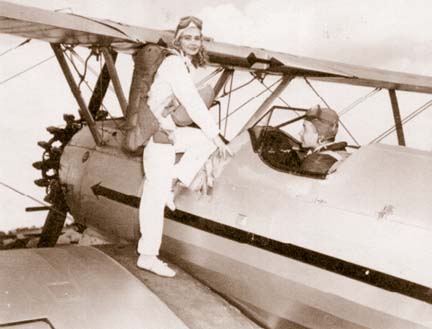Moskolonel
6 years agoLegend
WW2 girls
Hey! We have all followed the controversy of women in BFV and i create this post to give new examples putting an end to the controversy of detractors. Although uncommon there have been women, russia...
Vera Voloshina

The daughter of a miner and a schoolteacher, Vera Voloshina was born in the Siberian city of Kemerovo on 30 September 1919. After doing well in sports at school there, she moved to Moscow after the tenth grade. From 1936, she studied at the State Institute of Physical Education. While in Moscow, she attended the Aero Club where she practised parachute jumping and piloted a Polikarpov I-153 fighter plane. She attempted unsuccessfully to go to Spain to fight in the Spanish Civil War.
According to several accounts, the Soviet sculptor Ivan Shadr persuaded Voloshina to pose as a model for his 12-meter nude statue of the Girl with an Oar which was unveiled in Gorky Park in 1935.
Voloshina began to train at a sports institute but had to leave after experiencing serious health problems. Instead, she joined the Institute of Cooperation, completing her third year in 1941 before the outbreak of World War II. In the summer of 1941, she helped to dig trenches and anti-tank ditches around Moscow.
On joining the Red Army, she was assigned to Unit 9903 of the intelligence division, operating behind the German lines. After participating in several successful raids, on 21 November 1941 she was involved in sabotage work on the front when she was seriously injured near Naro-Fominsk and taken by the enemy. On 29 November, she was hanged by the Germans at Golovkovo Farm. Local residents later reported that she had acted defiantly before her hanging, singing The Internationale and shouting "Farewell, comrades" before she died. Her body was retrieved by the Soviets a week later, after the Germans had retreated. She was finally buried in a mass grave in Kryukovo.
Adeline Gray was just 24, but she was already an experienced parachutist and a trained pilot.
On this day in 1942, in an airfield near Hartford, Connecticut, Adeline Gray fell to earth for the 33rd time.
But something was different this time around: Gray wasn’t using a silk parachute. Rather, she floated down using a parachute made of nylon. She was the first person to test the nylon parachute, and it brought her nationwide fame. The approximately 50 senior military officials who were onsite to watch the test were impressed, writes Dorothy DeBisschop for the Oxford Patch.
Before World War II, most parachutes were made of silk, though some were cotton, and the majority of America’s parachute silk came from Japan. Parachutes were essential to American military strategy, not just to help pilots stay alive, but also to successfully drop troops behind enemy lines. More than 13,000 Allied paratroopers landed during D-Day, including men from the U.S. 82nd and 101st Airborne Divisions.
But as the Axis country cut ties with U.S. manufacturers, the DuPont company–which had by this point been manufacturing nylon stockings for years–stepped in and helped devise a parachute made of nylon, along with other nylon war goods. According to Connecticut History, the chemical corporation worked with the Pioneer Parachute Company and the Cheney Brothers Company, a silkmaker, to build a better ‘chute.
Pioneer eventually became the Pioneer Aerospace Corporation, a large corporation that still builds deceleration devices for NASA, among others. In 1942, Gray worked there as a parachute rigger and tester–a job that involved checking parachutes for flaws and folding them into packs for proper deployment. When the opportunity to actually test one of the new nylon ‘chutes arose, writes DeBisschop, Gray volunteered.

Newspaper coverage at the time marvelled at her coolness: “As calmly as if she were going out on the porch to bring in the daily paper… [she] stepped out of an airplane,” wrote the New York Times. Of course, it was nothing new for Gray. She was an experienced stunt parachutist with 32 jumps under her belt, and possibly the only woman parachutist in America during the time she was active. After she landed, reporters asked “the attractive Miss Gray” how she felt, reported the Times. Her response: “all right.”
Gray, who was 24 at the time of the 1942 jump, had been jumping for five years, as well as teaching parachuting to others, according to her obituary from the Naugatuck Daily News. She’d toured as a “barnstormer”–an airplane stunt performer–and she became a licensed pilot at age 21, her obituary records. Though the Times made no mention of these accomplishments, Gray was ideally suited for the task of testing the nylon parachute.
After the test, she benefited from her fame, writes DeBisschop. She was featured in a newspaper comic series and appeared in ads for Camel Cigarettes. “Camels are never harsh on my throat,” Gray is quoted as saying in one of the ads, which ran in magazines like Good Housekeeping and Time. In another ad, she’s shown wearing a ballgown.
Gray continued to work at Pioneer and later married aeronautics inventor Kenneth Johnson. She was the co-holder of a 1947 patent for a “parachute release mechanism” on which Johnson is credited as the inventor. Her obituary indicates that she and Johnson went on to have children, and she eventually remarried.
But her claim-to-fame remained the parachute: her obituary was headed “Woman Parachutist Dies at 59.” And that’s probably how she would have wanted it, writes Bisschop. Gray told one reporter that she had been interested in parachutes from childhood. “Back home in Oxford, I used to take an umbrella and jump off the hayloft holding it over my head like a parachute,” she is quoted as saying. “But I ruined many umbrellas.”
Thankfully, she didn’t ruin that nylon parachute.
